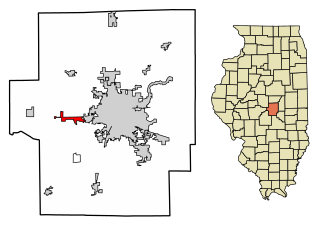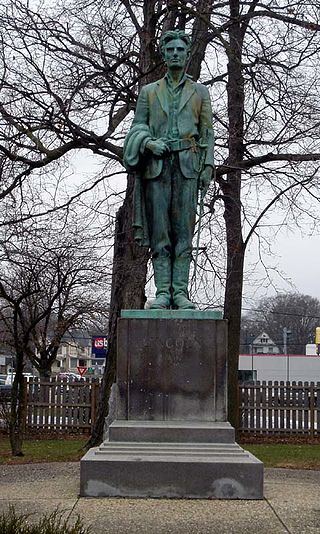Related Research Articles

Springfield is the capital city of the U.S. state of Illinois and the county seat of Sangamon County. The city's population was 114,394 at the 2020 census, which makes it the state's seventh most-populous city, the second largest outside of the Chicago metropolitan area, and the largest in central Illinois. Approximately 208,000 residents live in the Springfield metropolitan area.

The Lincoln Highway is one of the first transcontinental highways in the United States and one of the first highways designed expressly for automobiles. Conceived in 1912 by Indiana entrepreneur Carl G. Fisher, and formally dedicated October 31, 1913, the Lincoln Highway runs coast-to-coast from Times Square in New York City west to Lincoln Park in San Francisco. The full route originally ran through 13 states: New York, New Jersey, Pennsylvania, Ohio, Indiana, Illinois, Iowa, Nebraska, Colorado, Wyoming, Utah, Nevada, and California. In 1915, the "Colorado Loop" was removed, and in 1928, a realignment routed the Lincoln Highway through the northern tip of West Virginia. Thus, there are 14 states, 128 counties, and more than 700 cities, towns, and villages through which the highway passed at some time in its history.

Dixon is a city and the county seat of Lee County, Illinois, United States. The population was 15,733 as of the 2010 census, down from 15,941 in 2000. The city is named after founder John Dixon, who operated a rope ferry service across the Rock River, which runs through the city. The Illinois General Assembly designated Dixon as "Petunia Capital of Illinois" in 1999 and "The Catfish Capital of Illinois" in 2009.

Harristown is a village in Macon County, Illinois, United States. The population was 1,310 at the 2020 census. It is included in the Decatur, Illinois Metropolitan Statistical Area.

Southern Illinois, also known as Little Egypt, is a region of the U.S. state of Illinois comprising the southern third of the state, principally south of Interstate 70. Part of downstate Illinois, it is bordered by the two most voluminous rivers in the United States: the Mississippi below its connection with the Missouri River to the west and the Ohio River to the east and south, with the Wabash as a tributary.

Lincoln Memorial Bridge is a reinforced concrete, open-spandrel deck arch bridge built carrying U.S. Route 50 Business over the Wabash River between Vincennes, Indiana and Lawrence County, Illinois. It is said to mark the point where Abraham Lincoln crossed the Wabash River on his way to Illinois in 1830, and a sculptural installation, the Lincoln Trail State Memorial, marks the western end of the bridge.

Lincoln's New Salem State Historic Site is a reconstruction of the former village of New Salem in Menard County, Illinois, where Abraham Lincoln lived from 1831 to 1837. While in his twenties, the future U.S. President made his living in this village as a boatman, soldier in the Black Hawk War, general store owner, postmaster, surveyor, and rail splitter, and was first elected to the Illinois General Assembly.

George Rogers Clark National Historical Park, located in Vincennes, Indiana, on the banks of the Wabash River at what is believed to be the site of Fort Sackville, is a United States National Historical Park. President Calvin Coolidge authorized a classical memorial and President Franklin D. Roosevelt dedicated the completed structure in 1936.

Lincoln Boyhood National Memorial is a United States presidential memorial and a National Historic Landmark District in Lincoln City, Indiana. It preserves the farm site where Abraham Lincoln lived with his family from 1816 to 1830. During that time, he grew from a 7-year-old boy to a 21-year-old man. His mother, Nancy Hanks Lincoln, and at least 27 other settlers were buried here in the Pioneer Cemetery. His sister Sarah Lincoln Grigsby was buried in the nearby Little Pigeon Baptist Church cemetery, across the street at Lincoln State Park.
The Illinois Historic Preservation Division, formerly Illinois Historic Preservation Agency, is a governmental agency of the U.S. state of Illinois, and is a division of the Illinois Department of Natural Resources. It is tasked with the duty of maintaining State-owned historic sites, and maximizing their educational and recreational value to visitors or on-line users. In addition, it manages the process for applications within the state for additions to the National Register of Historic Places.
Note: A fully interactive online map of the Lincoln Highway and all of its re-alignments, markers, monuments and historic points of interest can be viewed at the Lincoln Highway Association Official Map website.

U.S. Route 66 was a United States Numbered Highway in Illinois that connected St. Louis, Missouri, and Chicago, Illinois. The historic Route 66, the Mother Road or Main Street of America, took long distance automobile travelers from Chicago to Southern California. The highway had previously been Illinois Route 4 and the road has now been largely replaced with Interstate 55 (I-55). Parts of the road still carry traffic and six separate portions of the roadbed have been listed on the National Register of Historic Places.
The Lincoln Trail Homestead State Park and Memorial is a 162-acre (66 ha) state park located on the Sangamon River in Macon County near Harristown, Illinois, United States.

Lincoln State Park is a state park of Indiana, United States. It is located in southern Indiana in Spencer County approximately 35 miles (56 km) east of Evansville.

The Lincoln Monument is a bronze statue of Abraham Lincoln that commemorates his 1832 service in the Black Hawk War. Located in President's Park in Dixon, Illinois, the bronze statue was sculpted by Leonard Crunelle and was dedicated on September 24, 1930. The memorial is maintained by the Illinois Historic Preservation Agency as a state historic site.

The Wabash County Courthouse is a historic governmental building in downtown Mount Carmel, Illinois, United States. Built in the late nineteenth century as the fifth courthouse in Wabash County, it has experienced a series of extensive remodelling projects that have left it with virtually nothing of the original building.

Little Pigeon Creek Community, also known as Little Pigeon Creek Settlement and Little Pigeon River settlement, was a settlement in present Carter and Clay Townships, Spencer County, Indiana along Little Pigeon Creek. The community, in the area of present-day Lincoln City, Indiana, was established from frontier land by 1816. There were sufficient settlers to the Indiana wilderness that it became a state in December, 1816.
The following outline is provided as an overview of and topical guide to Abraham Lincoln:
References
- 1 2 3 4 "Lincoln Trail Memorial". Illinois Historic Preservation Agency . Archived from the original on 2010-12-05. Retrieved 2012-01-04.